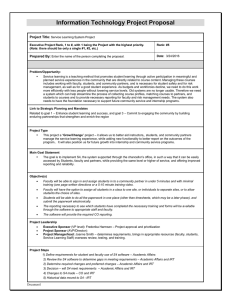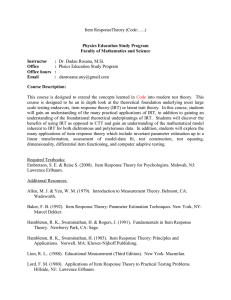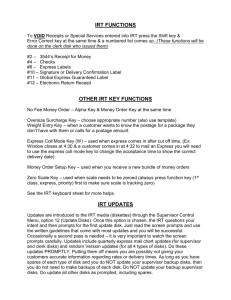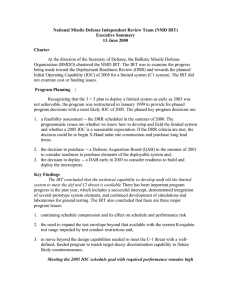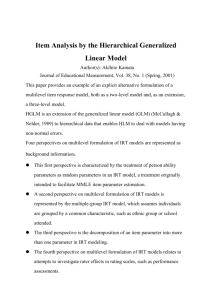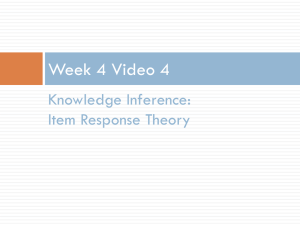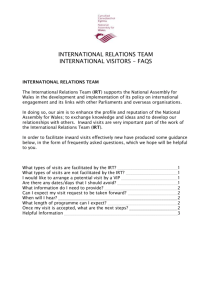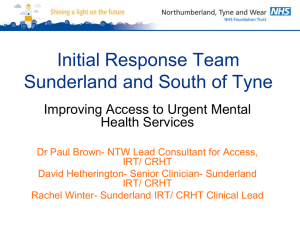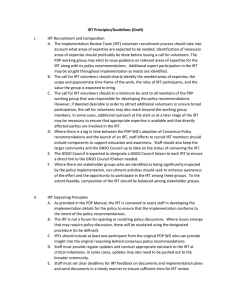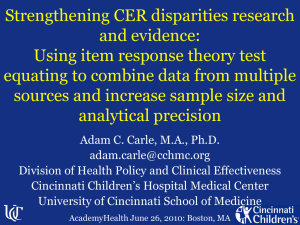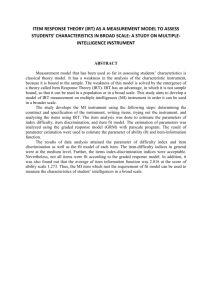Course description form
advertisement
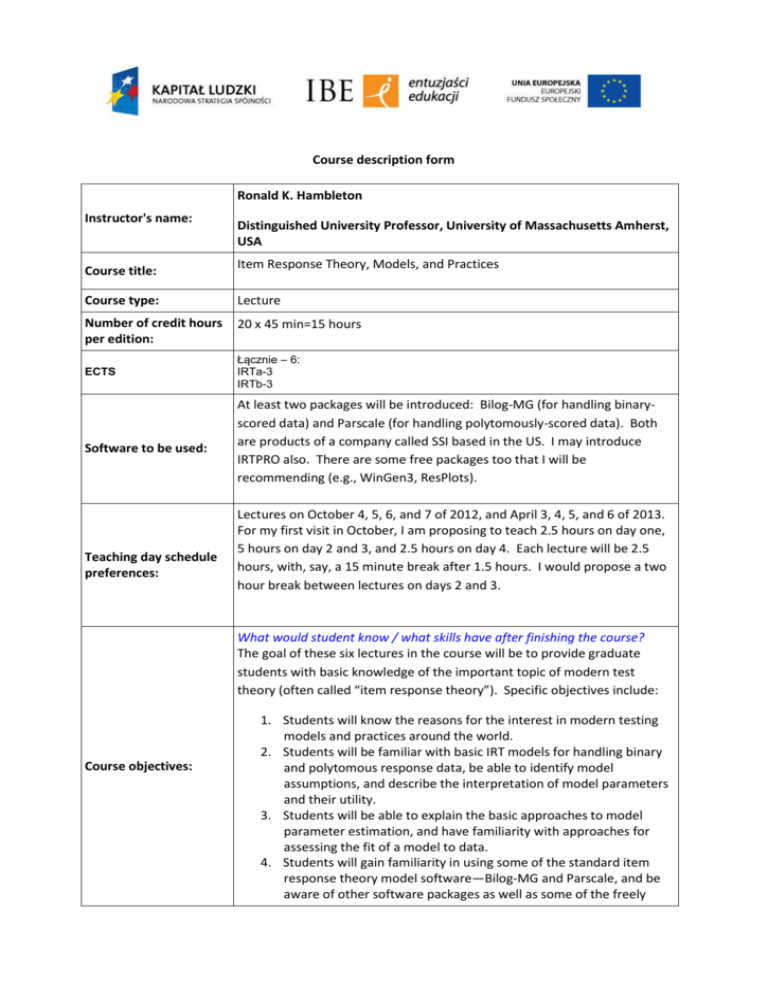
Course description form Ronald K. Hambleton Instructor's name: Course title: Distinguished University Professor, University of Massachusetts Amherst, USA Item Response Theory, Models, and Practices Course type: Lecture Number of credit hours per edition: 20 x 45 min=15 hours ECTS Software to be used: Teaching day schedule preferences: Łącznie – 6: IRTa-3 IRTb-3 At least two packages will be introduced: Bilog-MG (for handling binaryscored data) and Parscale (for handling polytomously-scored data). Both are products of a company called SSI based in the US. I may introduce IRTPRO also. There are some free packages too that I will be recommending (e.g., WinGen3, ResPlots). Lectures on October 4, 5, 6, and 7 of 2012, and April 3, 4, 5, and 6 of 2013. For my first visit in October, I am proposing to teach 2.5 hours on day one, 5 hours on day 2 and 3, and 2.5 hours on day 4. Each lecture will be 2.5 hours, with, say, a 15 minute break after 1.5 hours. I would propose a two hour break between lectures on days 2 and 3. What would student know / what skills have after finishing the course? The goal of these six lectures in the course will be to provide graduate students with basic knowledge of the important topic of modern test theory (often called “item response theory”). Specific objectives include: Course objectives: 1. Students will know the reasons for the interest in modern testing models and practices around the world. 2. Students will be familiar with basic IRT models for handling binary and polytomous response data, be able to identify model assumptions, and describe the interpretation of model parameters and their utility. 3. Students will be able to explain the basic approaches to model parameter estimation, and have familiarity with approaches for assessing the fit of a model to data. 4. Students will gain familiarity in using some of the standard item response theory model software—Bilog-MG and Parscale, and be aware of other software packages as well as some of the freely available software such as WinGen 3 and Resid Plots. 5. Students will be familiar with basic IRT concepts associated with test development, and have knowledge of how tests are constructed using IRT. 6. Students will be familiar with basic equating designs, and approaches for data analysis, one of the most common uses of IRT modeling. Prerequisites: Pass requirements: What particular knowledge / skills student should have prior to the course? It would be helpful for students to have at least one course in statistical methods. What form of assessment (if any) do you plan to conduct to evaluate students' knowledge / skills learned during the course, e.g. oral / written exam, written home assignment, etc. Students will need to complete one assignment satisfactorily, following the lectures in October, 2012. They will be asked to complete the assignment within a month after the six lectures. The assignments will consist of questions to allow candidates to demonstrate their understanding of the course content, their capability to review relevant literature, and their skills in analyzing test data using IRT software. Please list mandatory publications to be read prior to the course as well as required and suggested further readings . Cook, L. L., & Eignor, D. R. (1991). IRT equating methods. Educational Measurement: Issues and Practice, 10(3), 37-45. Gierl, M. J. Test construction. In B. S. Everitt & D. C. Howell (Eds.). (2005). Encyclopedia of statistics in behavioral sciences. West Sussex, England: John Wiley & Sons. Hambleton, R. K., Swaminathan, H., & Rogers, H. J. (1991). Fundamentals of item response theory. Thousand Oaks, CA: Sage. Recommended reading: Keller, L. Item response theory (IRT) models for polytomous response data. In B. S. Everitt & D. C. Howell. (Eds.). (2005), Encyclopedia of statistics in behavioral sciences (pp. 990-1003). West Sussex, England: John Wiley & Sons. Nering, M. L., & Ostini, R. (Eds.). (2010). Handbook of polytomous item response theory models. New York: Taylor and Francis. (A very clear review of the most popular of the polytomous response models. Stocking, M. L., & Lord, F. M. (1983). Developing a common metric in item response theory. Applied Psychological Measurement, 7(2), 201210. More articles will be added at a later time on the topics of IRT modeling of data, model fit, model comparisons, and plausible values methodology. Topics will be provided for each lecture. Please write what would be detailed plan of the course. What particular topics would be covered within the course? Please describe in details. Lecture 1. (Thursday, October 4, 2012) Shortcomings of classical test theory, introduction to item response theory including basic models (oneparameter, two-parameter, and three parameter) and assumptions, and concepts such as item characteristic functions, and test characteristic functions, and specific features of IRT models. Lecture 2 (Friday, October 5, 2012) Principle of local independence, maximum likelihood estimation, assessment of model fit (including checks on test dimensionality and ICC match to data using residuals), and basic IRT software (Bilog-MG) Course plan: Lecture 3 (Friday, October 5, 2012) Test development and IRT. This lecture will include an introduction to item and test information, test efficiency, uses of test information functions, and introduction to optimal item selection. Lecture 4 (Saturday, October 6, 2012) Introduction to IRT models for handling polytomous response data—nominal response model, partial credit model, generalized partial credit model, and graded response model. Lecture 5 (Saturday, October 6, 2012) Item parameter estimation, model fit, and software for IRT calibrations (Parscale), discussion of sample size. Time permitting: the use of simulation in IRT and related measurement research. Lecture 6 (Sunday, October 7, 2012) Equating of test scores with popular equating designs, and IRT equating methods, plausible values methodology. Time permitting: applications of IRT to computer adaptive testing, detection of item bias, and score reporting.
